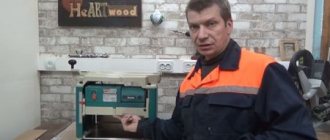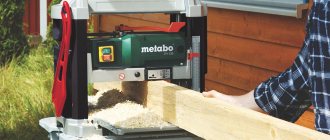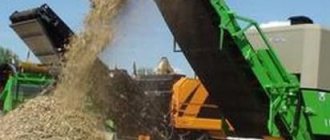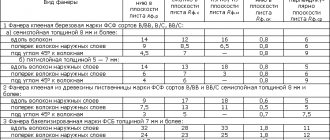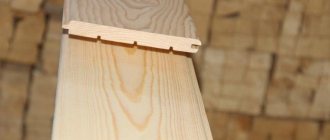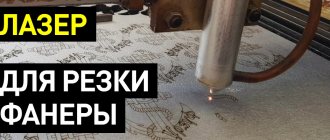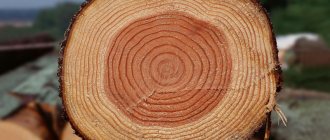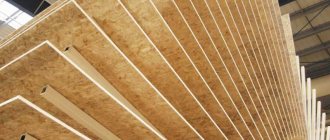Information about the manufacturer of the circular saw Ts6-2
Manufacturers and modifications of the Ts6-2 circular saw:
- Ts6-2 – Ussuriysk Machine-Building Plant, Danilovsky Woodworking Machine Plant
- Ts6-2(K) - Kirov Machine Tool Plant , founded in 1880.
- Ts6-2A – Astrakhan Machine Tool Plant
- Ts6-2D – Machine tool builder, Dnepropetrovsk
- Ts6-2IT – Tekhsnab Ivanovo
- Ts6-2K – StankoProm, Korsun-Shevchenko
- Ts6-2T – Equipment Siberian Industrial Company SPK Kemerovo
- Ts6-2M1 - China
Machine tools produced by the Kirov Machine Tool Plant, KSZ
- KPA-50
- round rod machine. Outlet diameter of parts Ø 20; 25; thirty; 35; 40; 45; 50 - SR-4
- thickness planer - TCPA-7
- sharpening machine for circular, frame and band saws - FSSH-1A
- milling machine - Ts6-2
- universal circular saw - TsM-120
is a multi-disc machine for sawing two- and three-edged timber (carriage) up to 120 mm high - TsM-150
is a multi-disc machine for sawing two- and three-edged timber (carriage) up to 150 mm high
Benefits of contacting us
- We design and manufacture machines ourselves. We control quality at all stages of production: from project development to installation and commissioning. We carry out modernization at the request of the client.
- We offer affordable prices. The cost of equipment from the Tyumen Machine Tool Plant is 3-4 times more profitable than foreign analogues.
- We guarantee quality. We use 100 years of experience in our company and provide a 1-year guarantee on all products.
- We will arrange delivery. We deliver throughout Tyumen and the region using our own transport; we organize transportation to other regions of Russia with the help of transport companies. We select the appropriate transport and calculate the shortest route.
- We provide related services. We sell spare parts, provide service and repair not only for our machines, but also for installations from other manufacturers.
Ts6-2 Universal circular saw with cross-cutting carriage. Purpose, scope
The universal circular saw machine model Ts6-2 is designed for longitudinal and transverse sawing of boards, beams, wood boards and sheet materials (chipboard, fibreboard, plywood, laminated paper, etc.).
Ts6-2 circular saw is general-purpose equipment for woodworking industries.
The following technological operations can be performed on the Ts6-2
- trimming unedged boards
- longitudinal cutting of edged materials into blanks of a certain cross section
- longitudinal cutting of timber blanks into edged boards and container boards
- longitudinal cutting of slab or sheet materials into blanks of a certain width based on a side guide ruler
- transverse cutting of bars (boards) based on a carriage
- cutting slab materials “into the corner” and “to size” based on the carriage
- cutting packages of workpieces “to size” with basing on the carriage and basing the end of the package on a given stop
- cutting slab or sheet materials at an angle to the edge according to the markings
The room where the Ts6-2 must meet the requirements of class P-II according to the PUE.
Ts6-2 machine can be operated in a temperature range from +10 to +40°C, with an average relative air humidity of no more than 80%, an altitude above sea level of up to 1000 meters in a non-explosive environment, in the absence of direct exposure to precipitation.
Type of climatic modification and category of machine placement - UHL4.2.
Category of storage conditions - 2 according to GOST 15150-69.
Ts6-2 machine complies with GOST 12.2.026-81 SSBT “Woodworking equipment. Circular saw machines. Safety requirements."
Symbol for woodworking machines
Woodworking machines and equipment are designated (indexed) with letters and numbers. Letter indexing consists of the initial letters of the name of the type or type of machine. The first letter means the type, the second and third are the main feature of the machine.
- C - circular saw (circular, circular)
- C - planing
- F - milling
- Ш - tenoning
- Tch - sharpening
- Kp - round rod
- U - universal
- PR - edge circular saw
- Central Committee - circular saw end leveler
- SF - planer and jointer
- SR - planer-thicknesser
- FS - milling with tenoning carriage
- FC - milling machine with rotary table
- SHO - single-sided tenoning
- SD - double-sided tenoning
- ShP - tenon cutter for straight tenon
- SHL - dovetail tenon cutter
- Shld - grinding disc
- ShlPS - grinding with a movable table
- TchP - saw sharpener
- TchN - knife sharpener
- TchPN - sharpening for saws and knives
The letter A indicates the presence of automation elements.
For example: SvPA—drilling and grooving machine with automatic feed. The number immediately after the letters or between them indicates the main parameters of the machines (number of cutting tools or planing width in mm, cm, dm). For example:
- Ts2K12 - two-spindle end leveler for bars 12 dm long
- SF-4 - planer and jointer with a planing width of 4 dm
- F2K - dual-spindle milling machine with rotary table
- ШО10 – single-sided tenon cutter for tenons up to 10 cm long
The number after the hyphen indicates the machine model number, for example:
- SF4-4 - fourth model
- SR6-6 - sixth model
- CP6-7 - respectively the seventh model
Design Features
Stationary models of circular saws are often used in large workshops, woodworking plants and sawmills. Being mounted on a massive base, it allows you to cut even large logs with ease. Characterized by high power ratings and large cutting depth.
So, the design of a stationary type circular saw includes the following components:
- The frame (base) of these equipment models is made of steel or cast iron. It is thanks to it that the equipment has massiveness and durability. Such machines, as a rule, are placed only on hard surfaces: concrete or asphalt.
- The working surface is also made of cast iron or steel alloys; it is very smooth. There is a groove in the surface of the tabletop designed to accommodate the saw. It also contains measuring devices and all kinds of guides.
- Circular saws are equipped with a high-power drive, which consists of a pulley and an electric motor. These elements are located under the tabletop structure.
- The box, which provides protection, prevents sawdust from flying towards the contractor.
- On automated models there is also a device that helps move workpieces.
Ts6-2 Arrangement of components of a circular saw universal machine
Arrangement of components of the circular saw universal machine Ts6-2
List of components of the circular saw universal machine Ts6-2(K):
- Bed - Ts6-2(K).10.000
- Caliper Ts6-2(K).20.000
- Lifting mechanism Ts6-2(K).30.000
- Carriage Ts6-2(K).40.000
- Guide ruler Ts6-2(K).50.000
- Fencing Ts6-2(K).60.000
- Electrical equipment Ts6-2(K).80.000
Ts6-2 Design and principle of operation of a universal circular saw machine
A general view of the machine with the designation of controls is shown in Figure 1. The machine has two control buttons: “Start” and “Stop” located on the fence bracket.
Overall dimensions of the working space of the Ts6-2 machine
Construction of the main components of the Ts6-2 machine
Description of the machine:
— The bed is a rigid welded box-shaped structure covered with a flat table. Inside the frame with a suspension attached to it there is a support with a drive and a mechanism for adjusting the height of the saw blade above the machine table.
— The support is a rigid swinging frame, in the front part of which there is a spindle, and at the rear there is a hinged suspension attached to the machine bed. At the bottom of the frame there is a hinge for attaching the lifting and lowering levers of the caliper and holes for the movable submotor plate of the machine drive. An electric motor is mounted on a movable plate. The lifting and lowering levers in the lower part are hinged to the machine frame, and a nut is installed in the middle of the levers.
— The guard serves to protect the saw blade during operation of the machine and prevent the workpiece from flying out towards the operator. It is an overturned welded box above the saw blade, to the side walls of which claw stops are suspended. The fence is suspended on a tubular bracket to the machine table. The guard covers the protruding part of the saw blade and the riving knife.
— The guide ruler serves to guide the material during longitudinal sawing. It is a movable beam that moves along the machine table parallel to the plane of the saw blade. The ruler is mounted on a movable slider that moves along a cylindrical rod fixed under the front edge of the table. The ruler is fixed in the selected location with a clamp.
— The carriage is used to move and guide lumber, lumber and panel blanks during precise cross-cutting and sawing at an angle to the face. It is a console, movable table installed in the same plane with the main table of the machine.
It moves manually on roller supports along cylindrical guide rods installed under the left side edge of the table parallel to the saw blade.
The carriage rollers are mounted on eccentric axes, which allows you to adjust the position of the carriage in height and inclination. At the rear edge of the carriage there is a rotating base ruler, against which the material to be cut is pressed during sawing. The ruler has a stop for sawing off a batch of workpieces “to size”.
The position of the stop is fixed with a screw clamp.
The screw is designed to adjust the position of the support in height, that is, to adjust the height of the saw above the machine table. In relation to the saw, this is done to ensure optimal cutting conditions and tool changes, which are carried out with the spindle in the lower position.
The screw engages the caliper arm nut. By rotating the screw using a handwheel located on the rear wall of the machine, the levers are rotated and, accordingly, the support (tool) is raised or lowered.
Machines from earlier years of production: circular saw Ts-5 and circular saw Ts-6
General view of the Ts-5 circular saw
General view of the circular saw universal machine Ts-5
- bed
- saw blade guard
- Desktop
- slot in the table
- saw blade top guard
- guide ruler
- push-button control panel
- lifting handwheel
General view of the Ts-6 circular saw
The universal circular saw machine Ts-6 with manual feed is designed for longitudinal and transverse sawing of lumber up to 400 mm wide and up to 130 mm thick
General view of the circular saw universal machine Ts-6
- a - general view;
- b - kinematic diagram of the tuning mechanism.
- spindle
- table
- mobile square
- fencing
- guide ruler
- handwheel of the saw support height adjustment mechanism
The machine has a saw spindle 1, a table 2 along which the workpiece is manually fed, a movable support square 3 for sawing across or at an angle, moved along a groove made in the table parallel to the saw blade, and a guide ruler 5.
The saw is set to the desired height by turning handwheel 6. A saw blade guard is installed on the table, ensuring safe operation. When longitudinal sawing, universal machines should be equipped with automatic feeders that provide mechanized feeding of workpieces.
Stationary equipment
Stationary circular saws are quite large. They are suitable for use by industrial companies performing impressive volumes of lumber processing. The engine has great power. The cast iron bed lasts a long time because its strength is above average. It is permissible to process hard wood when it is necessary to cut with a depth of 70–125 mm.
Equipment for the production of lumber
Designs on an extended bed represent a middle-class category, complemented by a convenient stand - a practical extension table on which a plane can be placed very easily. Such a unit is distinguished by significant power when compared with household analogues, and the cutting depth reaches 80–90 mm, that is, workers can easily saw workpieces of impressive sizes.
It is better not to buy the offered equipment on the markets. It must be guaranteed to be safe. It makes sense to look for professional stores that offer long-lasting models that will last for several years with intensive use.
Kinematic diagram of the circular saw universal machine Ts6-2
Kinematic diagram of the circular saw universal machine Ts6-2
Operation of the Ts6-2 machine
By turning on the input switch on the side wall of the electrical cabinet, power is supplied to the power and control circuits, and the signal lamp should light up. Depending on the intended type of work, tools and guides must be installed in advance, the stops and guide ruler must be adjusted. When performing longitudinal sawing operations, appropriate wooden pads must be installed on the guide fence. If cross cutting or cutting of sheet materials will be carried out, it is necessary to remove the riving knife. When longitudinally cutting short workpieces, it is necessary to prepare a pusher. By pressing the “Start” button, the machine drive is turned on and the material prepared for processing is manually fed to the rotating tool. If the material is large, then a second machine operator must support it on the other side of the machine.
Operating procedure on the machine
Preparation for initial start-up and initial start-up of the machine:
- ground the machine by connecting to the general workshop power supply system
- connect the machine to the electrical network, checking that the network voltage matches the electrical equipment of the machine
- follow the instructions given in the “Electrical equipment” section, check the correct direction of rotation of the electric motor
- become familiar with the purpose of handles and control buttons
- check the ease of rotation of the spindle by hand
- check the ease of making adjustment movements
- check the reliability of the anti-throwout claws of the fence, the ease of lowering them into a vertical position under the influence of their own weight
- check the alignment of the saw blade and the riving knife
- manually check that the tool is correctly secured to the machine spindle
To start up the machine for the first time you need to:
- turn on the main switch located on the side wall of the electrical cabinet, and the white signal lamp should light up
- turn on the spindle drive with the “Start” button
- make sure there is no unacceptable noise or excessive tool runout when the machine is idling
- turn off the machine by pressing the red “Stop” mushroom button, and the rotation of the saw should stop in no more than 6 seconds
ATTENTION : The machine is equipped with dynamic braking of the spindle drive. Frequent starts and stops lead to overheating of the motor windings. Do not abuse the frequent shutdown of the machine. The permissible frequency of machine braking is no more than once every 10 minutes and no more than 6 cycles per hour.
After making sure that the machine is operating normally at idle, we begin setting it up for operation.
Setting up a machine to perform a specific technological operation
The following adjustment operations are performed on the machine:
- The height of the saw blade above the machine table is adjusted to ensure optimal cutting conditions when sawing (the saw blade should protrude 10-20 mm above the top surface of the workpiece). The setting is performed by rotating the handwheel on the rear wall of the machine. When rotated clockwise, the tool rises, counterclockwise – it lowers
- Adjusting the width of the material to be cut during longitudinal processing or cutting “to size” is carried out by moving the side guide ruler relative to the saw blade. To do this, it is necessary to loosen the clamping screws of the slide and move it along the cylindrical rod to set it to the required position of the ruler. The ruler slider is fixed.
- adjustment of the cutting angle of lumber and panel parts is carried out to obtain blanks cut “on the miter” or corner panel parts. When based on a carriage, adjustment is made by turning and fixing the rotary guide ruler along a linear scale on which the main angles are marked. Angle cutting can be done according to the markings.
ATTENTION : When longitudinally cutting lumber, using a side guide ruler for basing the material, an overlay must be secured to the ruler (see Fig. 7);
Working on the Ts6-2 machine
Working on the machine includes the following operations: feeding workpieces to the machine and receiving processed workpieces from the machine.
All types of longitudinal cutting must be performed by two machine operators: one feeds and the other receives the resulting workpieces and, if necessary, returns the left half-cut part to the machine operator for reprocessing.
ATTENTION: Short workpieces less than 600 mm long must be processed using a pusher (see Fig. 8a).
Cross cutting of workpieces up to 12 kg and length up to 1500 mm can be performed by one machine operator. Large workpieces are processed with an assistant. Short scraps obtained when trimming “to size” along the back stop, and short parts are removed from the machine table using a pusher (Fig. 8b)
When longitudinally cutting lumber, a riving knife with a thickness of 4.5 mm must be installed behind the saw blade, symmetrically relative to the width of the cut. If the symmetry of the relative position of the saw and knife is violated, it must be adjusted using nuts.
ATTENTION: Cross cutting with a riving knife is not permitted!
Tool change
The tool is changed in the lower position of the caliper through the front door with the extreme right (initial) position of the carriage. To change tools you must use two keys.
It is recommended to sharpen saws on special sharpening machines. When changing tools, turn off the input switch.
Home mini-circular devices
Household mini-circular machines used by private individuals are endowed with their own characteristics. They are distinguished by limited functionality - performance is not industrial. A circular saw has low power, models are supplemented with discs, the diameter should be small. The largest parameter of a straight cut is not as large as that of industrial ones (range from 40 to 80 mm).
When choosing household sawing machines, you must remember that it is strictly forbidden to use them in processing large workpieces. Their task is to cope with the processing of workpieces of small width, ranging from 300 to 625 mm. Features of models of this class are considerable noise and vibration produced. There are several explanations. Household sawing machines operate on a direct drive and a gear reducer.
Their power is sufficient for simple wood cutting tasks. It is possible to process fairly dense material with high rigidity. But the machines have important advantages - for example, affordable cost.
Electrical circuit diagram of the circular saw universal machine Ts6-2(K)
Electrical diagram of the circular saw universal machine Ts6-2
Electrical equipment of the Ts6-2(K) machine. General information
The electrical equipment of the Ts6-2(K) machine is presented in the electrical circuit diagram (Fig. 3) and connection diagram (Fig. 4). The list of elements for the circuit (Fig. 3) is given in Table 5.
The electrical equipment of the machine is designed for connection to a three-phase alternating current network with a voltage of 380 V, a frequency of 50 Hz and ensures the possibility of its operation in fire hazardous areas of class P II in accordance with the classification of the Electrical Installation Rules of the Electrical Installation Regulations.
Protection of power circuits from short circuit currents, electric motor M from long-term overloads is carried out by the QF1 circuit breaker, control and signaling circuits by fuse FU1...FU4, and from long-term motor overloads by the thermal release of the QF1 circuit breaker.
The operation of the machine is controlled by buttons SB1 and SB2 located on the fence bracket. Electrical control equipment is located in an electrical cabinet located on the side wall of the machine.
The circuit provides for electrodynamic braking of the M engine after it is turned off. The engine should slow down in no more than 6 seconds. The permissible frequency of machine braking is no more than once every 10 minutes and no more than 6 cycles per hour.
Putting the machine into operation
Before starting the machine, it is necessary to externally check the quality of installation and the reliability of the grounding circuits. Turn on the input switch SA, and the HL lamp lights up, indicating that voltage is supplied to the machine circuit.
By pressing the SB2 button (5-6), turn on the rotation of the electric motor M. Stopping with braking occurs by pressing the SB1 button (4-5).
Machine blocking Ts6-2(K)
The electrical circuit of the machine provides the following interlocks:
- It is impossible to turn on the rotation of the electric motor M when the chip receiver door is open; this is achieved by introducing a closing contact of the limit switch SQ (6-7) into the control circuit of the motor M.
- It is impossible to turn on the electric motor M during electrodynamic braking; this is achieved by introducing the opening contact of the KM2 starter into the electric motor switching circuit (8-7)
- zero protection is carried out by block contacts of the magnetic starter KM1 (5-6)
Safety requirements
When installing, the machine must be reliably grounded in accordance with current rules and regulations. To do this, the contact clamp of the external protective circuit must be connected to the workshop grounding circuit. In addition, there is a grounding bolt on the machine bed.
When operating the machine, it is necessary to periodically check the condition of the electrical equipment, paying special attention to the condition of the contacts, as well as systematically carry out technical inspections and preventive repairs of electric motors.
The frequency of technical inspections is set depending on production conditions, but not less than once every two months. At the same time, the electric motor is cleaned of contaminants, and the reliability of grounding and connections is checked.
The frequency of preventive repairs is set at least once a year. During preventive maintenance, the electric motor is disassembled and internally cleaned, and the condition of the bearings is assessed. Lubrication in the bearings is included for the entire period of operation of the bearings and is designed for at least 12,000 hours of operation.
ATTENTION: When repairing electrical equipment, the input switch SA must be turned off.
Technical characteristics of the circular saw universal machine Ts6-2
| Parameter name | Ts6-2 | Ts6-2(K) | Ts6-2T |
| Basic machine parameters | |||
| The largest width of the sawn material when basing the material on the table along the guide ruler, mm | 400 | 500 | 400 |
| The largest width of the sawn material when basing the material on the carriage along the guide ruler, mm | 400 | 600 | 400 |
| Maximum thickness of the processed material during longitudinal sawing, mm | 100 | 125 | 110 |
| Maximum thickness of the processed material during cross-cutting, mm | 130 | 125 | 110 |
| Diameter of saw blade (circular saw), mm | 315..500 | 400 | 400 |
| Workpiece feeding method | Manual | Manual | Manual |
| Maximum lifting height of the saw support, mm | 100 | ||
| Angular speed of the saw shaft, rad/sec | 301,44 | ||
| Saw blade rotation speed, rpm | 2880 | 3180 | 3000 |
| Saw braking time, s, no more | 6 | ||
| Working surface of the table, mm | 830 x 1200 | 820 x 1115 | 700 x 1300 |
| Height of table surface above floor level, mm | 800 | 747 | |
| Stroke of the moving carriage, mm | 1000 | 977 | 900 |
| Working surface of the movable carriage table, mm | 510 x 590 | 450 x 600 | 550 x 700 |
| Diameter of the dust collector pipe, mm | 110 | ||
| Volume of sucked air, m/h | 810 | ||
| Electrical equipment of the machine | |||
| Type of supply current | 380V 50Hz | 380V 50Hz | 380V 50Hz |
| Number of electric motors on the machine, pcs. | 1 | 1 | 1 |
| Saw electric motor, kW | 4 | 4 | 4 |
| Dimensions and weight of the machine | |||
| Machine dimensions (length x width x height), mm | 1610 x 1505 x 1150 | 1410 x 1600 x 1095 | 1380 x 1300 x 1250 |
| Machine weight, kg | 815 | 405 | 620 |
- Circular saw Ts6-2. Operating manual, 1987
- Amalitsky V.V. Woodworking machines and tools, 2002
- Afanasyev A.F. Wood carving, Technique, Tools, Products, 2014
- Bobikov P.D. DIY furniture, 2004
- Borisov I.B. Wood processing, 1999
- Jackson A., Day D. Woodworking Bible, 2015
- Golden Book of woodworking for the owner of a country plot, 2015
- Ilyaev M.D. Wood carving, Master's lessons, 2015
- Komarov G.A. Four-sided longitudinal milling machines for wood processing, 1983
- Kondratyev Yu.N., Pitukhin A.V... Technology of wood products, Product design and calculation of materials, 2014
- Korotkov V. I. Woodworking machines, 2007
- Lyavdanskaya O.A., Lyubchich V.A., Bastaeva G.T. Basics of woodworking, 2011
- Lyubchenko V.I. Thicknessing machines for wood processing, 1983
- Manzhos F.M. Wood cutting machines, 1974
- Rasev A.I., Kosarin A.A. Hydrothermal processing and preserving of wood, textbook, 2010
- Ryzhenko V.I. The Complete Encyclopedia of Wood Art, 2010
- Rykunin S.N., Kandalina L.N. Woodworking technology, 2005
- Simonov M.N., Torgovnikov G.I. Debarkers, 1990
- Soloviev A.A., Korotkov V.I. Setting up woodworking equipment, 1987
- Sukhanov V.G. Circular saws for sawing wood, 1984
- Fokin S.V., Shportko O.N. Woodworking, Technologies and equipment, 2017
- Hilton Bill Woodworking, The Complete Guide to Stylish Home Furniture Making, 2017
Bibliography:
Related Links. Additional Information
- Directory of woodworking machines
- Manufacturers of woodworking machines and equipment
- Manufacturers of household woodworking machines
- Manufacturers of chipping machines
- Classification of woodworking machines
- Machines for longitudinal cutting of lumber
- Sawmill frames. Classification
- Lumber. Basic concepts. Terms and Definitions
Home About the company News Articles Price list Contacts Reference information Interesting video KPO woodworking machines Manufacturers
Circular (sawing) devices
Machines such as circular saws are used for sawing workpieces. The material being processed can be of all kinds, and the cutting direction can be:
- transverse;
- oblique;
- longitudinal;
- combined.
The equipment is a design used by all kinds of industries. Specialized stores most often offer sawing (circular) modifications for chipboard, wood and other wood materials. But if you prepare special disks, you will be able to work with other raw materials.
The constructive side is also interesting. In the traditional design of a stationary circular saw there are four main elements:
- bed;
- working surface;
- driving element;
- sawing tool.
Now at home they often use compact models that are not supplemented by a bed - they are placed on a suitable workbench. The described unit fits perfectly into small spaces.
The mini version of the tabletop sawing machine is a desktop version and has modest dimensions. It is used at home or in a workshop limited by meters. The structure weighs no more than 20 kg. Such a unit is easy to move to the work site.
Circular machine
